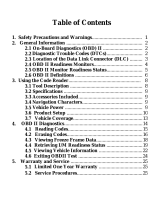
15
Government regulations mandate that all OBD II compliant vehicles must
have a “common” sixteen-pin Data Link Connector (DLC).
For your vehicle to be OBD II compliant it must have a 16-pin DLC (Data
Link Connector) under the dash and the Vehicle Emission Control
Information Label must state that the vehicle is OBD II compliant.
In addition to OBD II diagnosis, the ML619 scan tool also supports the ABS
and airbag diagnostic functions, dealing with more than 50 US, Asian and
European vehicles, including Acura, Audi, Bentley, Benz, BMW, Bugatti,
Chrysler, Ford, EU Ford, GM, Honda, Hyundai, Infiniti, Isuzu, Jaguar, Kia,
Land Rover, Lexus, Maybach, Mazda, Mini, Mitsubishi, Nissan, Opel,
Porsche, Saab, Scion, Seat, Skoda, Smart, Sprinter, Suzuki, Toyota,
Vauxhall, Volvo, VW, Renault, Peugeot, Lancia, Fiat, Dacia, Citroen, Alfa,
Abarth.
More vehicle supports will come out with new updates released.
Product Troubleshooting
This section describes problems that may be encountered while using the
scan tool.
Vehicle Linking Error
A communication error occurs if the scan tool fails to communicate with the
vehicle’s ECU (Engine Control Unit). Perform the following steps to resolve
error:
Verify that the ignition is ON.
Ensure the scan tool’s OBD II connector is securely
connected to the vehicle’s DLC.
Verify that the vehicle is OBDII compliant.
Turn the ignition off and wait for about 10 seconds. Turn the ignition
back to on and continue the testing.
Verify the control module is not defective.
Operating Error
If the scan tool freezes, then an exception occurs or the vehicle’s ECU
(Engine Control Unit) is too slow to respond to requests. You need to do the
following to reset the tool:






















